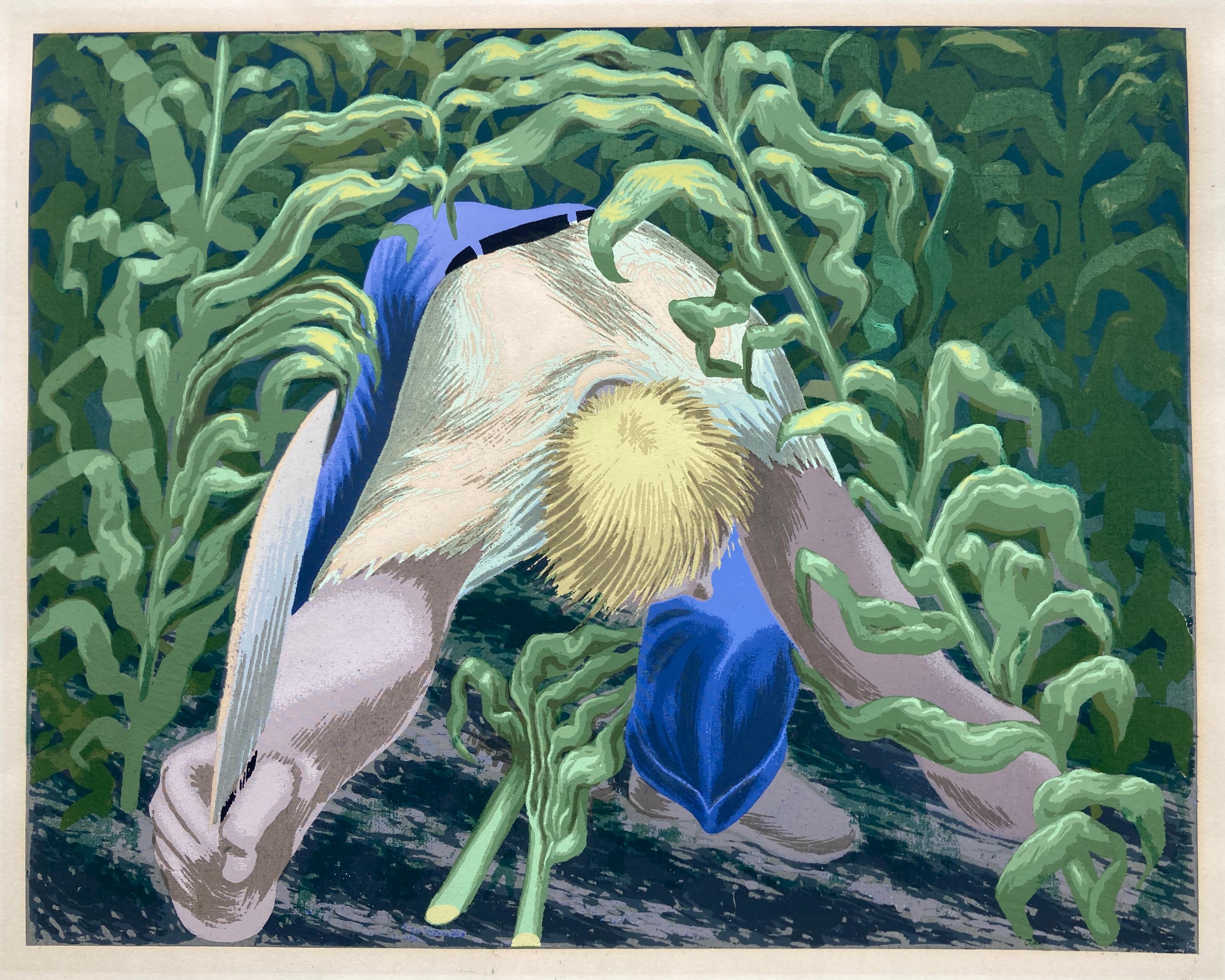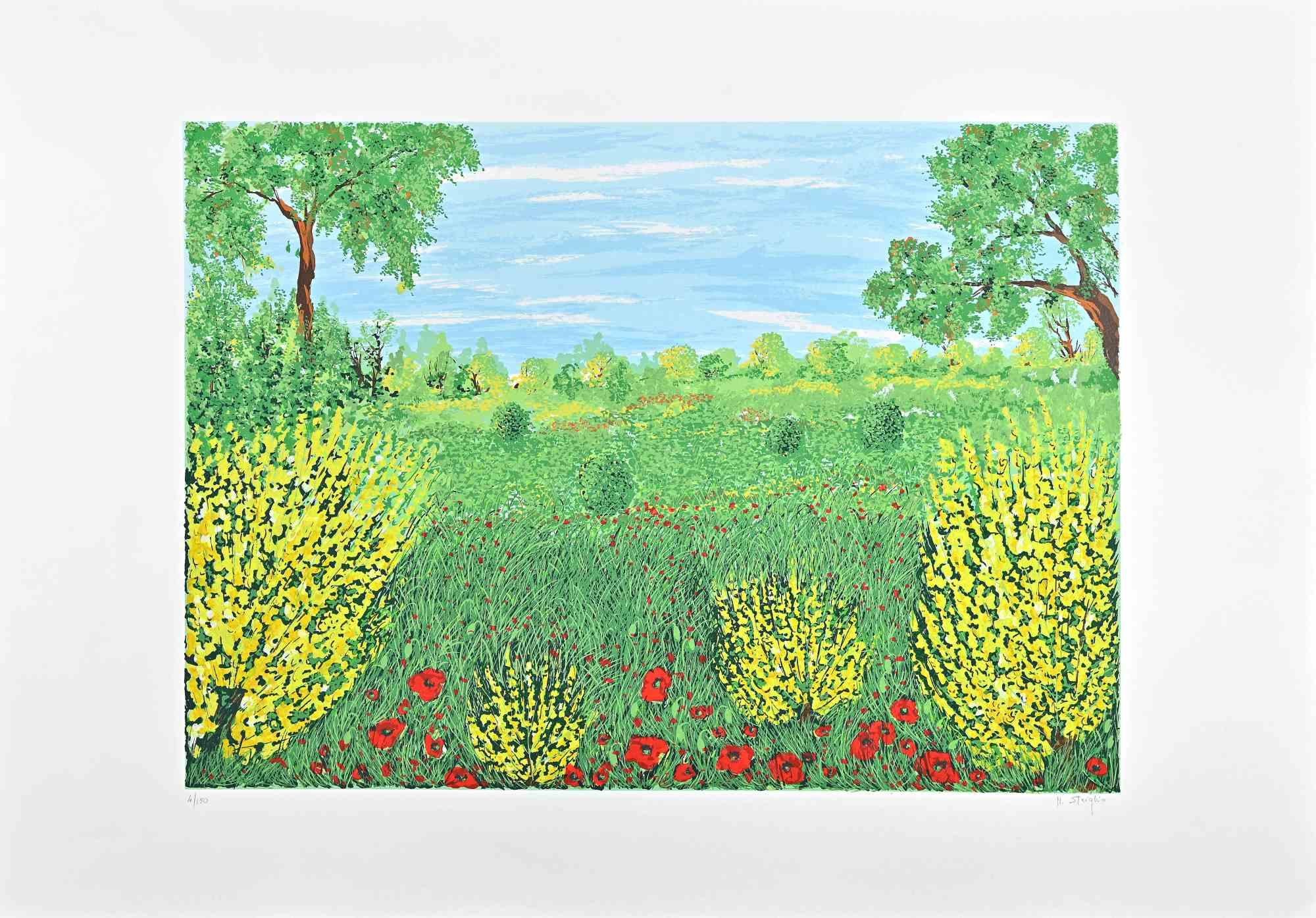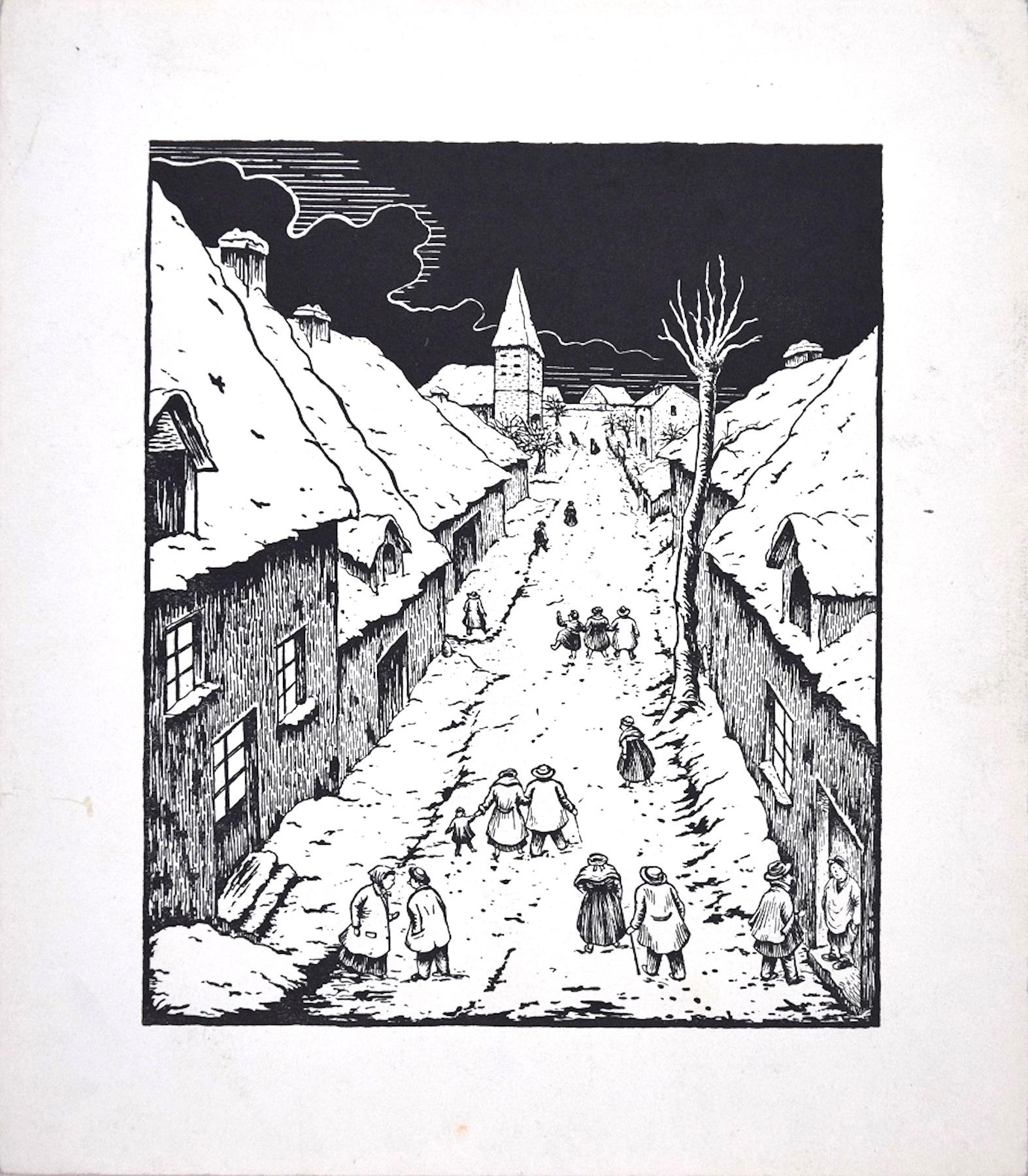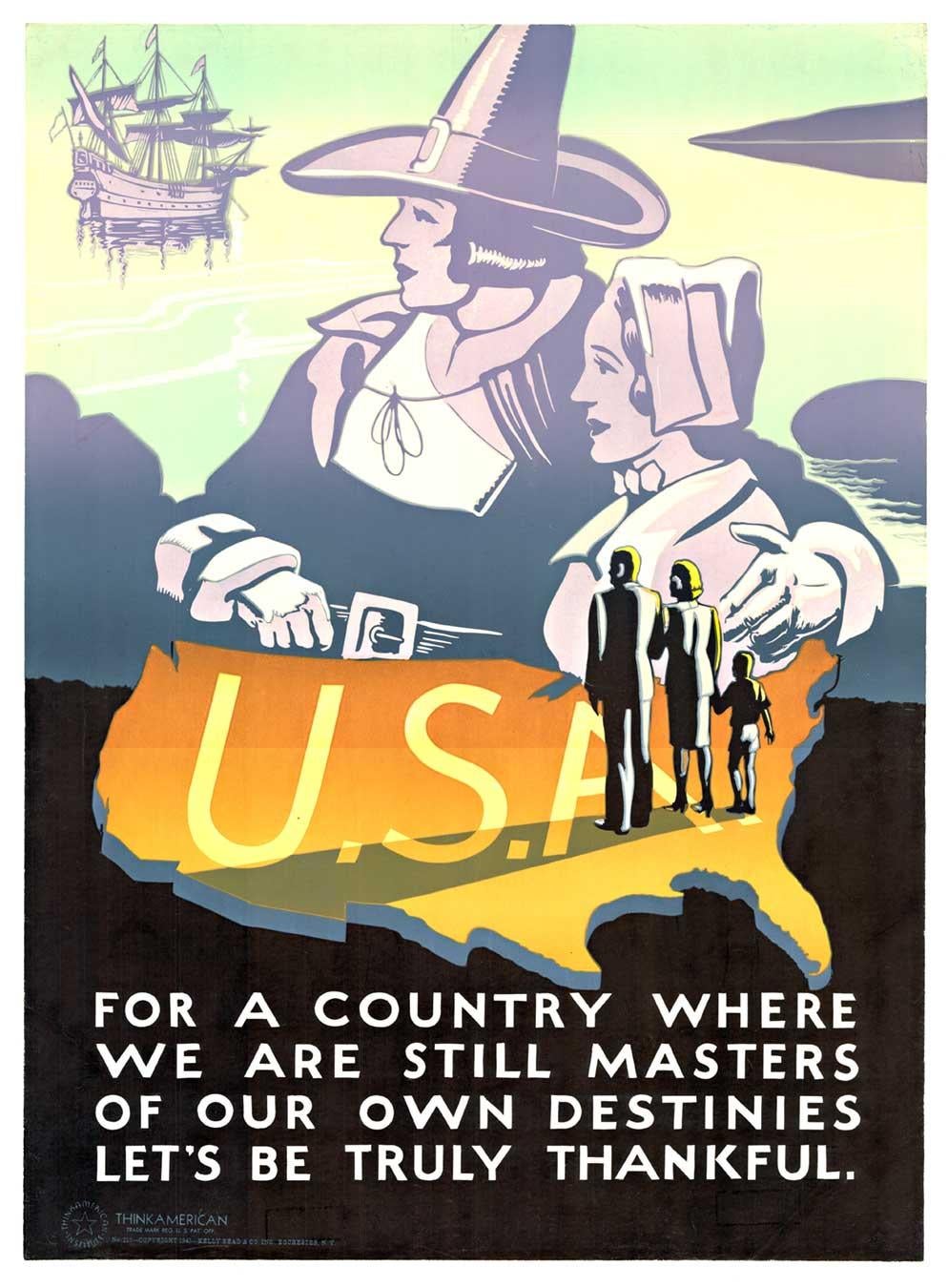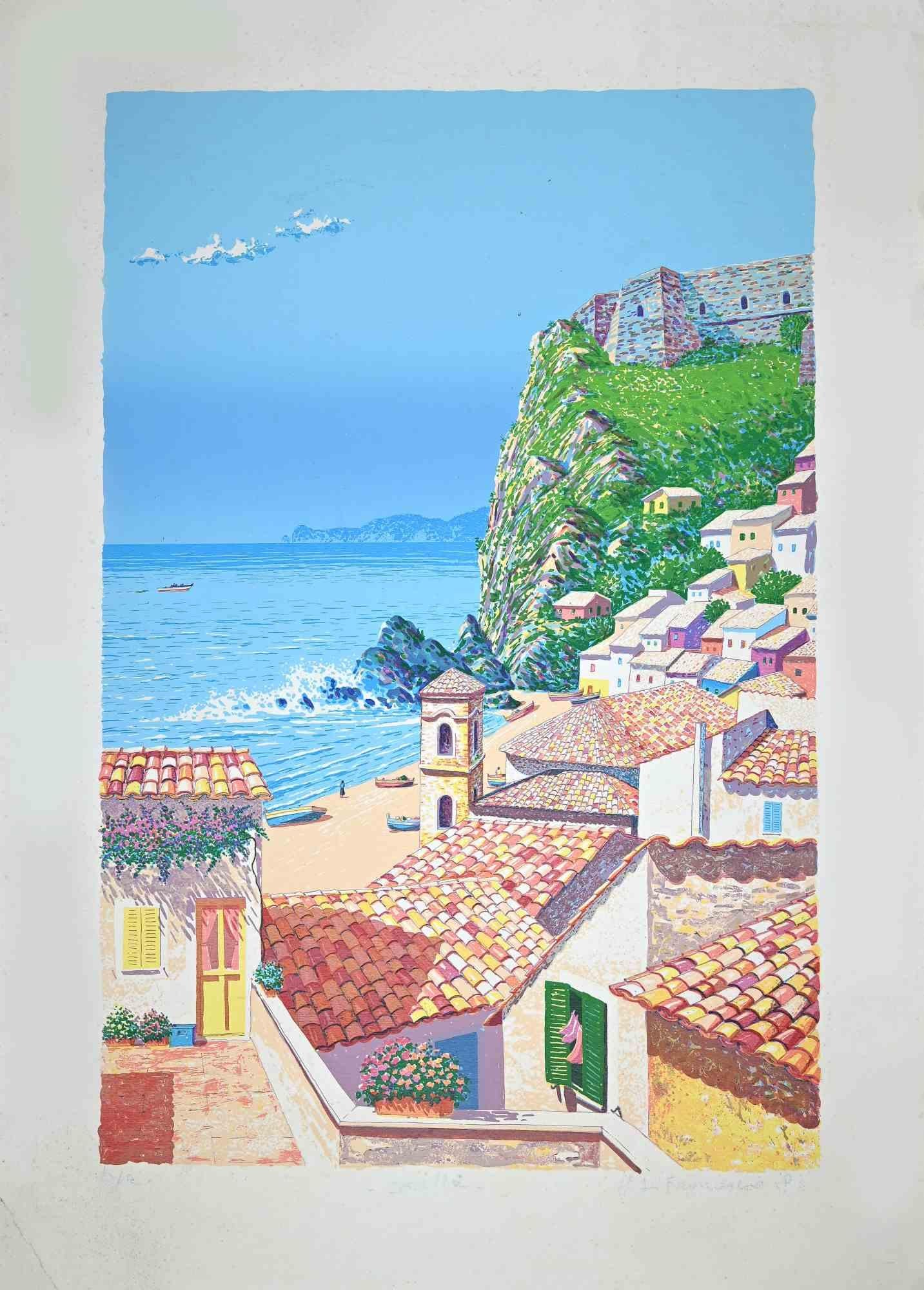Items Similar to Original "Japan" vintage travel poster serigraph bicycle
Want more images or videos?
Request additional images or videos from the seller
1 of 8
UnknownOriginal "Japan" vintage travel poster serigraph bicycle1972
1972
About the Item
Original Japan serigraph travel poster. Linen backed in very find condition, ready to frame.
Japanese travel posters have a rich history and are renowned for their captivating aesthetics, often blending traditional imagery with modern elements. In the 1970s, during the height of travel poster popularity, Japanese artists created numerous designs promoting tourism within the country and to international destinations. The poster you're referring to, produced by the American Screen Printing Co. in 1972, likely aimed to capture the essence of Japanese culture and scenery while appealing to an American audience.
Pagodas are iconic structures in Japanese architecture. They are multi-tiered towers, often found in temples or shrines, with each tier representing different elements of Buddhist cosmology. Pagodas are symbolic and instantly recognizable, making them a common motif in Japanese travel posters to evoke a sense of cultural heritage and spirituality.
Bicycles are a ubiquitous mode of transportation in Japan, especially in urban areas, where they are favored for their convenience and eco-friendliness. The poster's presence of a bicycle rider suggests mobility and exploration, inviting viewers to embark on their own journey and discover the beauty of Japan's landscapes and cityscapes.
This is an Original Serigraph Vintage Poster; it is not a reproduction.
- Creation Year:1972
- Dimensions:Height: 35 in (88.9 cm)Width: 23.5 in (59.69 cm)Depth: 0.05 in (1.27 mm)
- Medium:
- Movement & Style:
- Period:
- Condition:
- Gallery Location:Spokane, WA
- Reference Number:
About the Seller
5.0
Platinum Seller
These expertly vetted sellers are 1stDibs' most experienced sellers and are rated highest by our customers.
Established in 1998
1stDibs seller since 2020
161 sales on 1stDibs
Typical response time: 2 hours
- ShippingRetrieving quote...Ships From: Spokane, WA
- Return PolicyA return for this item may be initiated within 3 days of delivery.
More From This SellerView All
- Original "Think American" USA World War II vintage posterLocated in Spokane, WAOriginal poster: For a Country Where We Are Still Masters of Our Own Destinies, Let's Be Truly Thankful. Silk-screened patriotism. This is a poster meant to appeal to the American family. Soft, rich colors and a patriotic vision... This poster has been archivally mounted on linen and is in fine condition condition. Touched up pin-holes in the corners. A- condition. The Original Think American, USA World War 2 Poster is a captivating piece of history and art. This vintage poster showcases a unique design that captures the era's essence. It features a pilgrim couple gazing out to sea towards their three-master schooner, representing America's pioneering and adventurous spirit. The outline of the United States is a powerful symbol of national pride and strength. The large text along the bottom of the poster delivers a thought-provoking message, reminding viewers to be grateful for the country where they can shape their own destinies. Created and printed by Think America, a renowned brand, this poster is a true collector's item that celebrates American history and values. The ghosted image of early Pilgrims seems to reach out to the American family who are standing on an outline of the United States. The old sailing...Category
1940s American Modern Figurative Prints
MaterialsScreen
- Original "Wagon Lits" pop art style serigraph travel by train posterBy Valerio AdamiLocated in Spokane, WAOriginal “Wagon Lits” serigraph poster by the artist Valerio Adami. It was printed in France by GrafiCaza (Michel Caza), one of the finest serigraph companies on woven paper—in exce...Category
1990s American Modern Figurative Prints
MaterialsScreen
- Original Palm Springs and The Communities of The Coachella Valley vintage posterLocated in Spokane, WAOriginal Palm Springs, California, and the communities of the Coachella Valley vintage poster. A fun image map of the Palm Springs area and activities and hotspots to visit. Linen backed in very fine condition, ready to frame. The artist is E. Smith and the signature is below the sundial...Category
Late 20th Century American Modern Landscape Prints
MaterialsOffset
- Original American Airlines, St. Thomas / St. Croix vintage travel posterLocated in Spokane, WAOriginal American Airlines St. Thomas / St. Croix vintage trave poster. Archival linen backed in very good condition, ready to frame. Later edition o...Category
Late 20th Century American Modern Landscape Prints
MaterialsOffset
- Original Coca Cola "Our America #3 Motion Pictures vintage 1943 posterLocated in Spokane, WAOriginal. “OUR AMERICA, #3 USING MOTION PICTURES FOR SOCIAL VALUE.” vintage poster. Presented by the Coca-Cola Bottling Company. This poster displays the benefits of American Motion Picture making on society as a whole and is number three in the series of Our America, Motion Pictures. From leisure, as in entertainment, to the practical, like legal documentation and recording important events, are displayed in this poster. These benefits are shown in eight small windows along either side of a large ninth window, which is all brought into harmony by the use of green tones, and that the windows are set upon a mint green background. Presenting Facts of History. Our America Motion Pictures # 3. Using Motion Pictures for Social Values. 1. Using cartoons for amusement. 2. Reporting an important event. 3. Making biography dramatic. 4. Reporting athletic events. 5. Dramatizing a famous book. 6. Showing places of natural beauty. Y. Using motion pictures in legal cases. 8. Making pictures true to facts. We Can All Do Our Part! In 1943, during World War II, Coca-Cola created the “Our America” series of vintage motion picture posters...Category
1940s American Modern Figurative Prints
MaterialsOffset
- Original "Our America, #2 Producing Motion Pictures" vintage posterLocated in Spokane, WAOriginal: Our America Motion Pictures # 2. Printed: 1943 by the Coca-Cola Company. Archival linen backed. Excellent condition. Lithograph. Linen bac...Category
1940s American Modern Landscape Prints
MaterialsOffset
You May Also Like
- PULLING CORN (FODDER HOPPER) - Scarce Print!By Bernard Joseph SteffenLocated in Santa Monica, CABERNARD (JOSEPH) STEFFEN (1907 – 1980) PULLING CORN (FODDER HOPPER) c. 1935-45 Color serigraph signed with a full signature below the image at the lower right sheet edge . Unknown e...Category
1930s Modern Landscape Prints
MaterialsScreen
- Explosive Spring -Original ScreenPrint by Maddalena Striglio - Late 20th centuryLocated in Roma, ITExplosive Spring is a very brightly colored screen print realized by the contemporary Italian artist Maddalena Striglio in the late 20th Century. ...Category
Late 20th Century Modern Landscape Prints
MaterialsScreen
- Nocturnal Village - Original Screen Print by Lucie NavierBy Lucie NavierLocated in Roma, ITNocturnal Village is an original artwork realized by the French artist Lucie Navier (1910-1996) in the 1930s. Original black and white serigraph...Category
1930s Modern Landscape Prints
MaterialsScreen
- Sea View - Screen Print - 1990sLocated in Roma, ITSea View is an original Screen Print, realized by an anonymous artist in the 1990s. The status of preservation Good. The artwork is depicted skillfully thro...Category
1990s Modern Figurative Prints
MaterialsScreen
- Meadow with Poppies - Screen Print by Maddalena Striglio - Late 20th centuryLocated in Roma, ITMeadow with Poppies is a very brightly colored screen print realized by the contemporary Italian artist Maddalena Striglio in the late 20th Century. Hand-signed in pencil on the lo...Category
Late 20th Century Modern Landscape Prints
MaterialsScreen
- Modernist Silkscreen Screenprint 'El Station, Interior' NYC Subway, WPA ArtistBy Anthony VelonisLocated in Surfside, FLscreenprint printed in color ink on wove paper. New York City subway station interior. Anthony Velonis (1911 – 1997) was an American painter and designer born in New York City who helped introduce the public to silkscreen printing in the early 20th century. While employed under the federal Works Progress Administration, WPA during the Great Depression, Velonis brought the use of silkscreen printing as a fine art form, referred to as the "serigraph," into the mainstream. By his own request, he was not publicly credited for coining the term. He experimented and mastered techniques to print on a wide variety of materials, such as glass, plastics, and metal, thereby expanding the field. In the mid to late 20th century, the silkscreen technique became popular among other artists such as Robert Rauschenberg and Andy Warhol. Velonis was born into a relatively poor background of a Greek immigrant family and grew up in the tenements of New York City. Early on, he took creative inspiration from figures in his life such as his grandfather, an immigrant from the mountains in Greece, who was "an ecclesiastical painter, on Byzantine style." Velonis attended James Monroe High School in The Bronx, where he took on minor artistic roles such as the illustration of his high school yearbook. He eventually received a scholarship to the NYU College of Fine Arts, into which he was both surprised and ecstatic to have been admitted. Around this time he took to painting, watercolor, and sculpture, as well as various other art forms, hoping to find a niche that fit. He attended NYU until 1929, when the Great Depression started in the United States after the stock market crash. Around the year 1932, Velonis became interested in silk screen, together with fellow artist Fritz Brosius, and decided to investigate the practice. Working in his brother's sign shop, Velonis was able to master the silkscreen process. He reminisced in an interview three decades later that doing so was "plenty of fun," and that a lot of technology can be discovered through hard work, more so if it is worked on "little by little." Velonis was hired by Mayor LaGuardia in 1934 to promote the work of New York's city government via posters publicizing city projects. One such project required him to go on a commercial fishing trip to locations including New Bedford and Nantucket for a fortnight, where he primarily took photographs and notes, and made sketches. Afterward, for a period of roughly six months, he was occupied with creating paintings from these records. During this trip, Velonis developed true respect and affinity for the fishermen with whom he traveled, "the relatively uneducated person," in his words. Following this, Velonis began work with the Public Works of Art Project (PWAP), an offshoot of the Civil Works Administration (CWA), where he was assigned to serve the different city departments of New York. After the formation of the federal Works Progress Administration, which hired artists and sponsored projects in the arts, he also worked in theater. Velonis began working for the federal WPA in 1935. He kept this position until 1936 or 1938, at which point he began working in the graphic art division of the Federal Art Project, which he ultimately led. Under various elements of the WPA program, many young artists, writers and actors gained employment that helped them survive during the Depression, as well as contributing works that created an artistic legacy for the country. When interviewed in December 1994 by the Library of Congress about his time in the WPA, Velonis reflected that he had greatly enjoyed that period, saying that he liked the "excitement" and "meeting all the other artists with different points of view." He also said in a later interview that "the contact and the dialogue with all those artists and the work that took place was just invaluable." Among the young artists he hired was Edmond Casarella, who later developed an innovative technique using layered cardboard for woodcuts. Velonis introduced silkscreen printing to the Poster Division of the WPA. As he recalled in a 1965 interview: "I suggested that the Poster division would be a lot more productive and useful if they had an auxiliary screen printing project that worked along with them. And apparently this was very favorably received..." As a member of the Federal Art Project, a subdivision of the WPA, Velonis later approached the Public Use of Arts Committee (PUAC) for help in "propagandizing for art in the parks, in the subways, et cetera." Since the Federal Art Project could not be "self-promoting," an outside organization was required to advertise their art more extensively. During his employment with the Federal Art Project, Velonis created nine silkscreen posters for the federal government. Around 1937-1939 Velonis wrote a pamphlet titled "Technical Problems of the Artist: Technique of the Silkscreen Process," which was distributed to art centers run by the WPA around the country. It was considered very influential in encouraging artists to try this relatively inexpensive technique and stimulated printmaking across the country. In 1939, Velonis founded the Creative Printmakers Group, along with three others, including Hyman Warsager. They printed both their own works and those of other artists in their facility. This was considered the most important silkscreen shop of the period. The next year, Velonis founded the National Serigraph Society. It started out with relatively small commercial projects, such as "rather fancy" Christmas cards that were sold to many of the upscale Fifth Avenue shops...Category
1980s American Modern Figurative Prints
MaterialsScreen
Recently Viewed
View AllMore Ways To Browse
Japanese Original
Japan Vintage
Architecture Poster
Modern Travel Poster Art
Vintage Architecture Posters
Vintage Japanese Print
Japan Vintage Poster
Vintage Japanese Posters
Japan Travel Poster
Japanese Travel Posters
Bicycle Posters
Vintage Transportation Art
Temple Japanese Buddhist
Pagoda Landscape
Vintage Japanese Travel Posters
Vintage Shriners
Temple Shrine
Vintage Linen Tower
